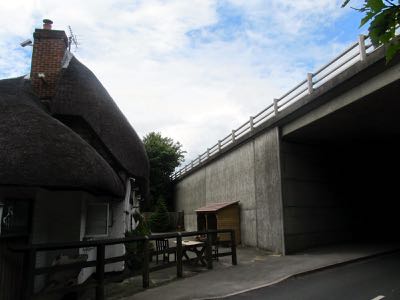
The White Horse, Thruxton
Day 1

The White Horse, Thruxton
We’ve just had a week in Cornwall. We broke the journey on the way down at Thruxton near Andover, staying in The White Horse - a 17th century thatched inn which used to stand on the A303. The A303 now passes by overhead on a bridge, so that the inn faces a 30 foot high concrete wall within about 10 feet of the front door.
Strangely, this barely diminishes the inn’s charm. From our bedroom window we looked out across the pub garden and a country lane to a field where horses grazed and a small pony stood up to his stomach in a fast-flowing river, apparently feasting on pond weed.
After we’d settled in, we drove off along winding lanes, past villages of thatched cottages that seemed to have sprouted out of the ground, so organic was their appearance. We were heading for the local Hawk and Owl trust, where we arrived in time to see a display of owls, from the massive Great Grey Owl to the diminutive Barn Owls.
They flew from perch to perch, tempted by titbits offered by the staff, skimming low over the heads of the audience – indeed, one owl’s wing actually brushed my hat. The finale was provided by a pair of Barn Owls, who, as well as flying to collect titbits, quartered the arena in a convincingly natural manner.
Returning to our inn, we enjoyed a very pleasant meal. I particularly enjoyed my starter of Arbroath Smokies with a soft-boiled duck’s egg in a light crunchy batter. The landlord was a tall, charming Australian, who walked with a stoop due to the low ceiling in the bar. I did find one spot in between two beams where I could stand upright, but I think he was possibly slightly taller than me.
Day 2
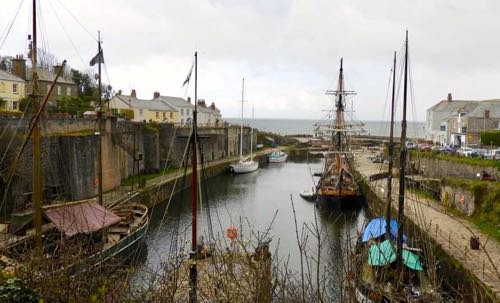
Charlestown. Photo © Jayne Gutteridge
Next morning, the landlord seemed to be the only person present at 8 o’clock to cook and serve our full English breakfast and send us on our way.
The weather, which had been pleasantly sunny for our first day became very changeable. We stopped off at Montacute House, and went round the gardens in a biting wind with wintry showers. We were glad when the house opened its doors so that we could get inside for a warm. Montacute House is famous for its Long Gallery on the upper floor, the pictures that hang in the gallery, and a 15th century tapestry of a knight on horseback. The previous week, they had discovered that the staircase was extremely fragile, so the upper floors were closed to the public. The tapestry was in one of the downstairs rooms, rolled up and wrapped in cloth ready to be sent off to Brussels to be cleaned, before being returned to the National Trust for conservation work. It will be on display again in about three years. It’s a splendid Elizabethan house, though.
We arrived at our hotel in Charlestown as the weather cleared a little. The hotel car park was massive, cobbled with large, irregular flints, and with a surface like a very choppy sea. The locals hurtled about this in their cars, bouncing in all directions. On enquiry, we were told that the car park was one of only two in the country that is Grade II listed, and the hotel was not allowed to touch it or alter it in any way.
We went for a walk round Charlestown, and along the coastal path as far as Porthpean and back. The harbour is used in the new series of Poldark, and is quite picturesque, with two or three tall ships moored in the inner harbour, behind a lock gate. The outer harbour, at high tide, was like a seething, boiling caldron, and the thought of manoeuvring one of the ships through the lock and round almost a right angle between high stone walls and out of the narrow entrance was intimidating.

Abseiling on a biome at the Eden Project. Photo © Jayne Gutteridge
Day 3
The main object of our holiday was to visit the Eden Project and the Lost Gardens of Heligan, both of which Jayne had visited before, but I hadn’t. So the next day saw us at the Eden Project.
We arrived at the door of the rainforest biome a few minutes after its official opening time, but they were holding a fire drill, so opening was delayed by a few minutes. The man in front of us went into meltdown, shouting at the girl on duty, and telling her that he had planned his day to the minute, and this five-minute delay had completely thrown things out. We quietly retreated and went round the Mediterranean biome first. Here we met several old botanic acquaintances from Australia in addition to the Mediterranean and South African species.
The rainforest, when we got to it, was very impressive, and we climbed up to the top and back. By the time we’d climbed back up to the reception area for a cup of tea, and then down through the various outdoor terraces and back again, I estimated we’d walked over three miles. Two men were climbing up one of the biomes and abseiling down again, cleaning the surfaces. An interesting job, I should imagine.
We always seem to get through our planned day quicker than anticipated, so in the afternoon we tried the coastal path in the opposite direction to the previous day, as far as Carlyon Bay. On the advice of a man in the information centre in the beach car park, we stopped off at the very friendly golf club house for a drink before heading back.
Day 4
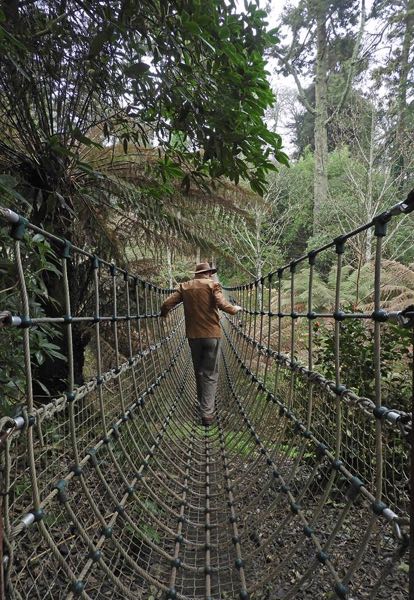
The Burmese Rope Bridge, Lost Gardens of Heligan.
Photo © Jayne Gutteridge
So far the weather had been variable – from rain to sun, but with a persistent cold wind. As we moved on from Charlestown towards our final destination, the weather worsened. We had planned to visit the Lost Gardens of Heligan on our way, and so we did. The gardens being sheltered, for the most part it was OK, only getting unpleasant in exposed areas. Having gone round half the gardens, we headed off down “Sunken Lane” towards “The Jungle”, and then climbed back up the jungle ravine, which was dramatic and picturesque. We crossed the “Burmese Rope Bridge”, which took both hands to hold on, so I carried my stick horizontally in one hand whilst simultaneously holding on to the rope with the same hand. About a third of the way across I saw something black fall between my feet and disappear into the undergrowth below. On reaching the other side, the noise of metal stick on wooden walkway made it clear that I’d lost the ferule.
We went through the walled gardens and back up through a small, rocky ravine to the exit where we had a cup of tea before setting off for Truro to do some shopping. Truro was elusive. I was sure I saw a sign for Truro on the way in, but it seemed to have vanished. We ended up in Mevagissey, described in guidebooks as a quaint fishing village with narrow streets. The bit about the streets is true.
Having done a circuit of the village, which entailed some reversing to get round narrow, sharp corners, we retraced our steps and, still not finding the sign I’d seen previously, drove almost to St Austell to pick up the main road to Truro. The first thing we found was a Waitrose, where we bought some food to start us off self-catering, and also a park and ride.
Jayne asked at the bus waiting room information desk as to which stop was best to get off the bus in town, saying that she’d never used this park & Ride before, “so I’m a virgin”, at which the man got very excited and not only produced a town map and marked the best stops to get off and to catch the bus back, but very enthusiastically marked it with everything that was worth visiting in the town centre and mapped out a route for us to follow. On the hunt for a replacement ferule, we entered an outdoor shop, where I found a lightweight waterproof jacket reduced to a very reasonable £19. I’d forgotten to pack a waterproof coat, so was reliant on my leather jacket to keep me dry.
Following the route marked for us on the map, we next found a shoe repair shop where a very obliging man supplied a replacement ferule. We visited the cathedral and the museum and caught the bus back, and then set out for our destination – the tiny hamlet of Bohortha on the Roseland peninsula.
I like driving on narrow roads, and I had several miles of them to negotiate before we arrived at the Old School House – a Dame School dating from the 1840s. It was a delightful little cottage, but no amount of scrutiny of the welcome folder revealed a password for the WiFi. The very good reason for this was that there wasn’t any WiFi in the hamlet at all.
After I’d got over the shock and we’d settled in and had a meal, we set out on a short stroll to find the landing stage for the ferry to St Mawes. The ferry goes from a place called “Place”. In this part of Cornwall, Manor Houses are called Places, and the ferry went from near to Place House. Having waded through some very sticky mud, we descended a steep hill, and went through a small wood, emerging at a slipway at the end of a road. A footpath sign pointed along the coastal path, saying “Ferry 200 meters”, and close by was a sign put up by the ferry company, saying “Ferry 100 yards”. Thus we calculated that a Cornish yard was 2 metres long.
We walked to the landing stage where there was a sign with a timetable, under which was a hand-written sign saying “Ferry on demand only” with a mobile number, and tucked into this was a red diamond with the words “Ferry not running”.
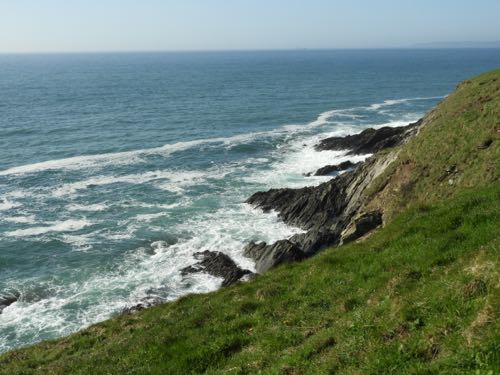
From the coastal footpath. Photo © Jayne Gutteridge
Day 5
The next morning the sun shone from a cloudless sky. It had occurred to us that we were a long way from any shops or pubs, and that we needed more food, so after a light breakfast we set out along the coastal path to Portscatho, signposted as being two and a half miles to the north. After walking for about three miles, and getting a bit hot, we checked the map and found we were about a third of the way there. We saw choughs, greater black-backed gulls, cormorants, buzzards and a stonechat, and watched seals playing in the surf.
The sound of the sea was ever–present and continuous. There was still a stiff breeze, and a heavy swell, causing waves to crash into the cliffs in a dramatic fashion. We got our second wind, and eventually descended into the village, hungry and thirsty.
The pub had a sign outside saying “Food served all day”. We tried several doors to the pub, and the third one opened, but the lady behind the bar said they didn’t open until noon. We briefly considered waiting half an hour, but instead went to the café across the road. As we had been staying at B&Bs so far, we’d been having a full English (or Cornish) breakfast. We were suffering from withdrawal symptoms. The menu said that they served full English breakfast until 11.30. Were we too late? The proprietor looked her watch, thought for a second, and said, “No, that’s alright”.
So we had our second breakfast, entertainment being provided by an ambulance crew treating a lady who’d tripped on the café steps and broken her arm. Apparently, she’d had the plaster removed from her other arm a week before, having broken that one.
We visited the village store and the village butcher, and saw a sign to the museum and information centre. We climbed half way up the hill to the latter, but lost interest, and came back down.
Laden with provisions, we climbed a steep set of steps between houses to take a slightly shorter, inland route home, stopping at Porth on the way for a cup of tea from the Thirstea tea company van www.thethirsteacompany.co.uk.
Strange to relate, having got home, after a sit down and a cup of tea, we felt like having a walk. We set off along the coastal path in the opposite direction towards St Anthony Head, where there is a Second World War bunker and a lighthouse which is the one used for the children’s programme, Fraggle Rock. Continuing round, we eventually came to St Anthony Church, nestling behind Place House. After a sit-down in a pew, we plodded on, up the steep hill and through the mud to Bohortha. We felt we’d had a full day.
Day 6
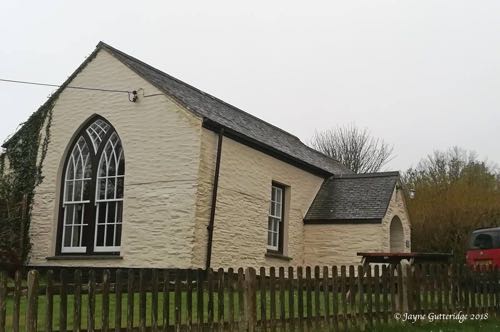
The Old School House, Bohortha. Photo © Jayne Gutteridge
I woke at six the next morning to see a red sun rising out of the sea into a cloudless sky. Our bedroom was the old schoolroom, with a massive window in the gable end giving a splendid view. We decided to try and catch the ferry to St Mawes. However, by the time we were ready to leave a thick mist had come down. Jayne tried to phone the ferry number but got no reply, so we set off through the mud to Place to see what was going on.
We were near the landing stage when we saw the ferry was arriving, so hurried along, behind the hedge, to meet it. A man was standing at the top of the steps to the landing stage, and the ferryman called out to him, “Did you want the ferry?” “No, thank you,” he replied, and “Yes, please!” we shouted from behind our hedge.
Landing at St Mawes, we walked along the front and up the hill to the castle – a neat little fort built by Henry VIII, which is in a state of near-perfect preservation. It has a companion fort on the point over at Falmouth. By the time we’d been round the castle the mist was clearing and the sun was starting to break through.
St Mawes is a pleasant little town on a steep hill, but after looking around, doing a little shopping and having a drink and a snack in a waterfront café, we went to catch the ferry back. As there were unusually low spring tides, the ferry was not able to run during the afternoon, so it was a case of leave at mid-day or wait until evening.
Back on the other side, we decided to walk back the long way round by walking north on the coastal path and then cutting inland to come down to Bohortha. The final stretch of path into the hamlet was just as wet and muddy as the others.
I decided to do some sunbathing on the lawn, and then we crossed the road to look at the cows with their calves, with a pair of buzzards gliding above us. Then I made a cottage pie for our evening meal.
After that, we felt a bit restless, so we decided to go to Percuil, a tiny hamlet to the north, where Jayne had read of a nice short circular walk, overlooking Percuil River on one side and Pelyn Creek on the other.

Paddling at Kynance cove. Photo © Jayne Gutteridge
Day 7
One of the reasons we chose this part of Cornwall was that I mentioned that I had never visited the Lizard, so today we got the car out. First we drove to the nearby village of St Just in Roseland, where Jayne had read of a 12th century church that was worth visiting. We parked in the village and walked down to the church perched on the water’s edge and surrounded by a very large graveyard clinging to the hillside, with shrubs, flowers, winding paths and a little meandering stream with pools every so often. Delightful.
We returned to the car park via a footpath which afforded splendid views of Falmouth and the countryside on the opposite bank of the River Fal. To cross the river, we drove to the King Harry Floating Bridge – a large chain ferry which clanks its way across and back every 20 minutes throughout the day. It was quite busy.
On the opposite bank was Trelisick House and Gardens, a National Trust property. The gardens were very pleasant, the camellias, rhododendrons and magnolias being in full bloom.
The house has only recently been passed to the National Trust, and was the home of one of the early female MPs, Ida Copeland, who won her seat as a conservative in the Stoke Potteries, where her husband was a director of Spode, against Oswald Mosely, who stood representing what he then called “The New Party”, but later named more honestly “The British Union of Fascists”. Reading about him, the analogies with Farage were telling, although Farage is a very weak, pathetic creature compared to the charismatic but thoroughly evil Mosely. I was interested to read that one of the Conservative campaign slogans in the 1931 election was “Strong and Stable Government”.
Besides the house and gardens, with beautiful views over the hills and river, there are extensive woodlands and meadows and an iron-age fort, but we were on a mission, so pressed on towards Falmouth and beyond, and down the long road to the Lizard. Leaving the car in the car park, we followed a footpath sign to Lizard Point, but were lured by a way-marking arrow into another path which brought us to another headland across a gully with a little stream.
Turning east, we headed towards Lizard Point, and thought we had reached it, but found it was another headland again. We could see the point and the lighthouse, so decided that was near enough and headed back to the village for a Cornish ice cream.
Driving out of Lizard village, we decided to explore Kynance Cove, which was worth the very steep and stony decent. Having established that the tide had just started coming in, I risked a paddle in the heavy surf. I wouldn’t have wanted to do it if the tide was going out. The waves pushed hard at me as they came in, but hardly subsided before the next one piled on top of it. One moment I was standing on a dry beach, and the next I was up to my thighs in water. It was easy to imagine how one could be dragged out by an ebb tide.
Stopping off at a supermarket for supplies, we retraced our route over the King Harry Ferry, arriving back at Bohortha tired and hungry, and Jayne rustled up a very welcome fry-up of sausage, egg, mushrooms, fried potatoes and beans.
Day 8

Proof of my swim. Photo © Jayne Gutteridge
I had brought my swimming trunks, and was determined to use them, so after a lazy morning at the Old School House we walked about three quarters of a mile to Porth beach in time to meet the incoming tide. There were several bodysurfers about in wetsuits, but I was the only bather in trunks.
The water was crystal clear (I even saw the silver flash of fish swimming past) and freezing cold, but I soon became numb enough not to feel it. Another man in trunks stood on the edge of the surf and asked if it was cold, which I confirmed. He stood thinking about it for a long time, then gave up. One brave lady came in and swam back to the shore again, but I swam up and down for a while, then went to see how Jayne was getting on with her rock pool hunting.
She said she’d tried to get a picture of me swimming, but there were too many children in the water and she didn’t want people to think she was photographing them, so I went back for another swim, and she managed to get a few shots of me swimming. Having seen them, I wish she hadn’t. Her powerful lens is a bit too unforgiving!
As I left the water, a little boy in wet suit and lifejacket latched onto me, chattering away, and once out on the beach, he gave me a double thumbs-up and said, “That was awesome! Let’s go in again together!” I declined and hastened away to re-join Jayne, thinking how sad it was that one can no longer chat innocently with a little boy without feeling uncomfortable, and wondering where his parents were. A bit later he returned with a man and another little boy, but talking to the man, we discovered the boy was nothing to do with him either, and the parents were somewhere at the top of the beach.
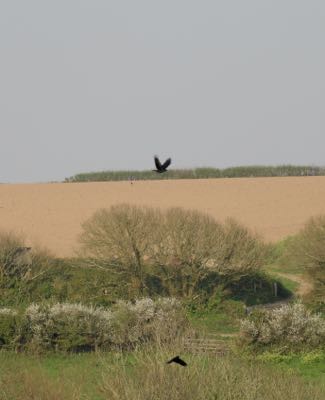
Choughs. Note the one flying upside down!
Photo © Jayne Gutteridge
Buying ice creams from the Thirstea van, we returned home via the coastal footpath. Although the sign at the St Anthony end saying that Portscatho was only two and a half miles away was obviously a blatant lie, we found we arrived home feeling fresh and invigorated rather than shattered.
I went to the loo, and was disconcerted to not be able at first to find anything in my shorts. The water was obviously even colder than I realised!
I was sitting reading in the garden when I heard the “Chuff!” “Chuff!” calls of agitated choughs, and looking up, saw a pair of them over the road, mobbing a buzzard. They took it in turns to land on their enemy’s back, driving the buzzard lower and lower. Presumably, if they had succeeded in grounding it, they could have made a concerted and possibly fatal attack whilst avoiding their opponent’s beak and talons. The buzzard managed to slip away from under them as it reached the edge of a slight slope.
Later, as we sat at our window watching the cows in the field over the road, the choughs appeared to perform a victory display, wheeling and diving together for the sheer joy of it.
After tea we went for another walk via inland footpaths to Porth and back via the road.
Day 9
For the first time since we arrived, the day broke with grey skies, so our decision to go to Falmouth rather than walking in the countryside looked a good one. We’d set the alarm for 7.30 to catch the ferry from Place, so when I woke up and looked blearily at my watch, reading 7.25, I thought I’d go and make some tea and get breakfast. Returning to the bedroom with the breakfast tray, I looked at my watch again with clearer eyes, and found it said 6.40, so I retreated to the kitchen, leaving Jayne to sleep.
Having caught the ferry to St Mawes, we transferred to the bigger ferry to Falmouth, sitting on the upper, open deck for the views. It was a bit chilly. Probably because of the cold, I felt the need of relief as soon as we got off the boat, so visited a public convenience in a car park. When I came out, Jayne was highly amused by a sign on the wall of the building, which read:

photo © Jayne Gutteridge
The first item on our agenda once we landed in Falmouth was to visit Pendennis Castle on the tip of the peninsula – Henry VIII’s sister fort to the one across the estuary at St Mawes. This is a much larger complex, but lacks the charm of St Mawes, which is almost completely unchanged from Henry VIII’s original plan. At Pendennis, his original round fort has a square Elizabethan extension, is surrounded by Elizabethan walls with a 17th century gate house, and has 18th century buildings, an Edwardian Royal Artillery garrison building and WWII gun emplacements.
Returning along the other side of the peninsula, we discovered that Falmouth has two faces. To the north, it is one of the deepest water ports in the world, with docks, and keys and a pier for the various ferries that ply up the rivers and creeks and across to St Mawes and for the fishing boats, and to the south it is a seaside resort with hotels and beaches facing the sea.
We had fish and chips for lunch – local line-caught haddock – and walked down the main shopping street, which had a large selection of small, privately owned shops in addition to the usual chains. We looked in at the maritime museum, but decided against paying the entrance fee.
The weather was turning cold with intermittent showers, so we decided to catch the next ferry back. On the way out, a young lad in the crew was obviously on his first day, and was having difficulty mastering the two round turns and a half hitch required for mooring. As the ferry arrived at Falmouth to collect us he was still struggling, but as we moored at St Mawes, a great cry of “YESSS!!!!” went up from the mate, and the skipper emerged from his wheelhouse with an even louder YEEESSSS!!!! as the lad got it right first time. He stood on the jetty steps, glowing with pride, to see the passengers off.
The Place ferryman had only the two of us to take, and said he’d had a very quiet day with only 27 passengers all day. There were 3 waiting at Place for him to take back, making it a round 30. We climbed the hill up to Bohortha and arrived home more exhausted than we had been all week, but the clouds cleared away and the sun came out making a pleasant end to the day.
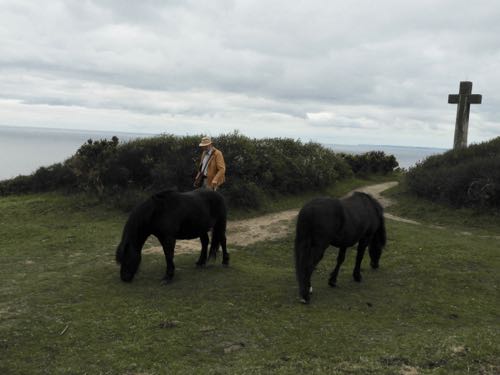
Dodman Point. Photo © Jayne Gutteridge
Day 10
For our last day at the Old School House we drove north to visit Dodman Point, which has an Iron Age fort and field system on it.
The roads grew progressively narrower, windier and steeper until the plants and brambles on the Cornish hedges were brushing both sides of the car at once. We came down a steep slope, crossed a ford, and up a very steep slope on the other side in first gear with the wheels spinning on the loose gravel. Several bends later we realised we’d passed the car park, and turning round, found that it was only signposted from one direction, presumably because nobody was expected to be daft enough to come the way we did.
Walking up a farm track towards the point, we came to the Bulwark – a massive Iron Age embankment, twenty feet high in places, stretching across from one side of the headland to the other. It was an impressive piece of construction. We continued on past various earthworks until we came out on the point in a cold, stiff breeze. A few ponies were grazing there, under a huge granite Victorian cross. Returning to the car, we drove on to Gorran Haven in search of, amongst other things, some toilet paper.
The road to Gorran Haven was as narrow as the previous one, though less windy and after a while we came to a gated common with some black cattle on it. Having driven through the gate off the common, we descended steeply into the village and parked in the car park. Signs warned you not to drive any further into the village, as the one street is very narrow, and becomes one-way from the opposite direction after a short distance.
It was a largely unspoilt little fishing village with a tiny harbour and beach. We climbed the steep hill away from the beach, stopping to look in the sturdy little church half way up. At the top we came upon a very classy modern hotel where Jayne had a coffee and I had a half of Tribute.
Retracing our steps, we bought toilet paper and a couple of Cornish Pasties in the Post Office, and drove on to Gorran Church – a separate village nearby, stopping to look in St Gorran’s church, which had some very hefty and ancient looking oak pew ends, covered in carvings.
On the homeward journey we stopped off at Nare Head. This involved more negotiation of Cornish lanes culminating in a seemingly endless and increasingly rough road to the car park. We walked up the track to where there was a National Trust board explaining that Nare Head was among the places where, in World War II, fake lights and special effects were set up to lure enemy bombers away from, in this case, Falmouth Docks. If the Germans fell for the deception and started dropping bombs, explosions could be set off so that they would think they’d hit their targets. There is also a nuclear bunker there, where, in the event of a nuclear war, two members of the Royal Observer Corps would have been incarcerated for up to three weeks to measure radiation.
Just off the point was a tiny, rocky island called Gull Rock. Three little rocks broke the surface in a line stretching out from Gull Rock, and the map told me that they were called, prosaically, Inner Stone, Middle Stone and Outer Stone.
We scrambled down to a tiny cove called Tregagle’s Hole, and up a very steep ravine back to the car.
Day 11

Stonehenge. Photo © Jayne Gutteridge
We set off towards home in a thick, drizzly fog after a very enjoyable week in Roseland. On the way we stopped at Lytes Cary Manor in Somerset – a charming little 15th century manor house with 16th century additions which was bought in a dilapidated state in the late 19th century by Sir Walter Jenner, a military man. He and his wife restored it, furnished it with suitable antiques, built a new wing and created “Arts and Crafts” gardens. They lived there with their daughter, who died aged 32. Sir Walter lived to be 88, and left the house and estate to the National Trust.
Moving on, we called at Stonehenge. We’ve looked at it before over the fence, but as we’re now English Heritage members, we decided to look at it from inside the fence at no cost (it’s £22 per person!). The museum at the new centre was interesting and informative.
We elected to walk the 2 kilometres to the henge rather than take the shuttle bus, partly for the exercise, and partly because I felt it was a more fitting way to approach it. The approach is by what remains of the recently closed road, which seemed a bit of a slog, being buzzed regularly by returning shuttle busses. There are several footpaths over National Trust property either side of the road, by which we could probably have had a more pleasant walk if we’d known where they went.
Arriving at the henge, we walked round it on the path provided, still quite a distance from the stones. I had hoped it would look more impressive close-to, but found that it still looks disappointingly small and untidy. Also, as I heard one lady saying, “it’s not even on the top of the hill”. The closure of the road has helped, but the A303 still pounds past not far away. I haven’t looked into the controversial tunnel proposal, but feel it would have to be an improvement. We caught the shuttle bus back, and looked in the overpriced shop, decided against a very overpriced cardboard cup of tea, and continued our journey.
Passing the henge on the A303, we found that the traffic slows to a crawl as people look at it as they drive past. The many lorry drivers on the route must get really pissed off with it, especially as they have a steep hill to climb afterwards.
We spent the night at the White Horse in Thruxton again, and had the same meal as previously, but a different waitress. We said to the landlord that we had a table booked for six. He squinted at the clock, smiled and said, “and it’s nearly six now. Flo should pop up in a minute (or at least I hope so) and she’ll take your order.”
About two minutes past six, the door from the car park burst open and a diminutive bundle of energy bounced in and started hurtling around the restaurant and the bar. As she whizzed past us, she smiled and said, “be with you in a minute” and was gone again.
Flying past again, she kicked open the service door to the kitchen and disappeared inside, yelling, “Hello sexy!” to the chef. She came out again, and said to us, “Soup of the day, we’ve got two. One’s beef and… No, hang on, that’s the pies.”
Hidden behind a thick mask of make-up, with suicide blond hair in a tight ponytail into which she stuck her pen, she was a likeable individual in her twenties, and once she stopped to think, she was efficient.
After our meal, we went for a walk to the post box. “Under the bridge and it’s at the top of the hill,” said Flo. “Going up’s a bit blrrr, but coming down’s nice.” Passing under the A303, we had a difference of opinion as to which road to take – the slight incline into the village, or the right turn, which was steeper but appeared to me to head off into open countryside. Jayne maintained that the road into the village couldn’t be described as a hill, so we set off to the right, and of course, at the top of the hill, found the post box.
Day 12
As before, Mine Host was on his own to cook and serve our breakfast and see us off.
On our many journeys to and from the west of Britain, we like to stop off at Thrift Farm for a break. Situated just west of the magic roundabouts of Milton Keynes, it’s a charity which has animals for petting and plants for sale, and also raises its own pigs, sheep and chickens and grows its own vegetables to sell in their food shop and cafeteria. For the most part they employ people with learning disabilities or other problems. Their food and drink and the service are excellent.
On this occasion, we were still so full of our White Horse full English breakfast that all we could manage was a coffee.
Text © Chris Gutteridge 2018